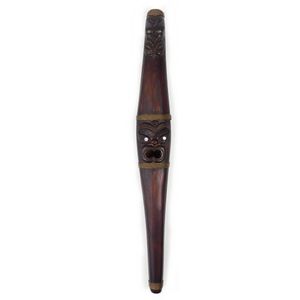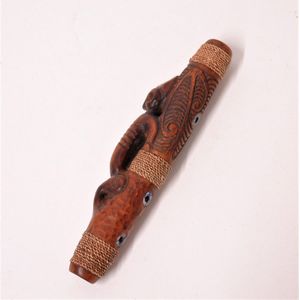
Gendered Ceremonial Paddles with Maori Motifs
A pair of 20th century ceremonial paddles, carved male and female forms. The male plays a putorino, the female with te moko and hands placed to belly. 102 cm length

Nguru: Maori Nose Flute with Divine Musical Connection
Nguru, nose flute, ngati Raukawa, Aotearoa, the singing voice of Hineraukataui, the Maori goddess of music is said to be heard when the Ngauru is played. Nguru are played by blowing air from the nose directly into the flutes opening. Carved from a single…

Wheku Nguru Flute
Nguru (nose flute), light brown color with two holes to the front and three to the reverse of the body. Wheku head carved in relief to one end. 15 cm length.

Maori Carved Putorino with Masks and Paua Inserts
A mid-late 20th century Maori carved putorino (bugle flute) traditional tapered form with two carved masks, paua inserts, waxed thread binding, length 49 cm. Not registered.

Maori Full Relief Carved Koauau Flute
A 20th century Maori carved traditional koauau (flute), carved in full relief with stylised full figure, the body with kowhaiwhai and adzed designs, three finger holes outlined with paua, bound with fine woven fibre. Length 22 cm.

Maori Carved Koauau on Antler Stand
A contemporary Maori carved koauau (flute), the exterior profusely carved with Maori motifs, on antler stand. Maker's mark of three crossed fish. Height 18 cm

Maori Kauau Flute with Paua Shell Outlining
A Maori contemporary carved kauau flute, with three finger holes outlined with paua shell. Length 16 cm

Maori Double Flute with Face Motif and Fibre Binding
Maori double flute, unusual form double flute with incised face motif on both terminals. Finely wrought fibre binding. Provenance: Purchased from Senta Taft at Galleries Primitif, Paddington circa 1970. New Zealand, 49 cm

Marine Ivory Nguru Flute from New Zealand
Important nguru flute. This artefact is a marine ivory nguru given to Commander James Wood RN on one of his journeys to New Zealand between 1837 and 1843 the artefact comes to auction from the present owner who is a direct descendent of Commander Wood.…
 Loading more...
Loading more...